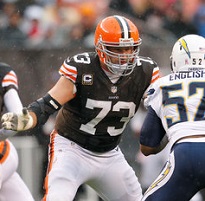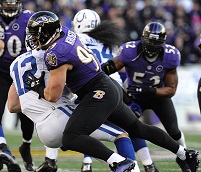[adsenseyu1]
Whenever a new contract pops up our immediate reaction is to compare it with someone else often in an effort to make it sound greater than it really is. The reality is that it is often very difficult to compare contracts and one or two numbers is never going to paint the real picture. There are many factors that come into play with a deal and you may often come up with two answers based on how you decide to value a contract. I can safely say that Aaron Rodgers contract is worth far more money than Joe Flacco’s, but I can also safely say that Flacco’s deal is far more player friendly and has a higher likelihood of being earned. While I’m as guilty as anyone with the comparisons I do try to paint a complete picture of contract comparisons. With Ryan Clady’s contract being the latest “biggest deal” I thought it was worth walking through some of the comparison difficulties.
New Money vs Total Money
This is the most difficult concept to work into contract comparisons. Contract extensions for the most part are contracts signed that have time remaining on the contract, often one year and sometimes more. When we value a deal we report the new money in the contract. To calculate new money you add together the yearly cash flows of the entire deal (for a 5 year extension with 1 year remaining that would be 6 years) and subtract out of that the cash flow component of the old contract. When we report on items like three year totals we are really adding many more years than three and subtracting the old money from the deal.
But is that fair? Take Joe Thomas for example as he is the most likely comparison to Clady. His three year “new money” total is $42 million. Clady’s deal can’t compare with that, but Thomas’ take is over a 4 year period. His actual three year salary on the total contract is $38.9 million. Again that is more than Clady but it’s much closer. In order to really put the “new” money valuations in perspective you have to look at contract structure which we will touch on in a bit.
Length of Contract
The initial comparisons of deals often come in terms of annual value per year and guaranteed salary. But there are major differences in those numbers based on years. APY can be misleading. Is the deal frontloaded? Is it backloaded? Do the additional years bring up the value or diminish the value. The great player contracts have backend numbers that diminish the value which we can calculate by items such as percent paid out over x amount of years or APY per each year. Thomas’ deal fits into this category and so should Clady’s. The great team deal has backend salary that artificially inflates the APY, an example of which was D’Brickashaw Fergusons contract with the Jets.
Guarantees can also be misstated. I like to look at guarantee per year or percent guaranteed more than the total guarantee. If I am giving up 7 years of my career to a team I need to be compensated for it. Thomas’ contract contained a whopping $44 million in guarantees, but that is on a 7 year deal. On a per year basis that is $6.28 million. On a percentage basis its 54.6%. If we just take into account potential full guarantees those numbers reduce. With a reported $33 million in guarantees on a 5 year deal Clady’s guarantee is as high as $6.6 million a year and 62.9% of the total contract. Now which sounds better?
You can take it a step further as well and factor in life earnings. Assuming players complete their deals how old will they be when they can re-sign. Clady will be 32 when he re-enters free agency. Thomas will be 35. Who has a better chance of earning another deal? Clearly the 32 year old. If the cap ever increases maybe Clady can make up that additional money Thomas received in his contract.
Contractual Structure
It is also important to take into consideration what happens if the player is not a great player over the life of the deal. Things change rapidly in the league and a deal that offers as much protection to the player as possible may be worth more than the deal with little protection that is valued higher. I often like to look at deals in terms of “virtual” guarantees, the point at which the salary cap implications begin to favor the release of the player. I tend to look at a few items when it comes to determining what is the true value of the contract.
Cap Savings- This is your very basic cap charge minus dead money in a given a year. Once it turns positive leverage goes from the player to the team and makes releasing the player more likely.
CSC Ratio- This calculation I use is the cap savings plus the cash savings divided by a players cap charge. I consider this to be a measurement of overall worth to a team to cutting a player. Remember a contract has both a cash and a cap component when you cut a player you save cash and may save or lose cap space. If the number is greater than the cap charge a team has reason to release.
Replacement Cost- While it is impossible to project this number ahead of time it puts more depth to the cap savings. This can be calculated by taking the cap savings of a release and subtracting out what cost a replacement player is. If you only save $2 million but the cost of a replacement is $5 million in cap dollars it is likely not worth cutting the player unless the cash component is that significant.
These are all important items to look at especially when we look at new money deals and seeing just how long those “new” years will really run. By agreeing to early extensions your contract structure is going to be much weaker than a newly signed deal.
Incentive Structures
This is often another big portion of confusion with a deal. We saw that tonight with Clady where the deal was originally reported as $57.5 million only to quickly learn that number included $5 million in potential escalators. Until earned we should always value at the base value of the contract. That $57.5 figure is likely important to Clady because it gives them a chance to reach the same APY as Thomas. The problem with that and as its being reported is that Thomas deal also contains $3.5 million in escalators, which , if earned, make his deal impossible to match.
With these escalators in place the details of earning them becomes important. Thomas’ are easier to earn because they are tied to Pro Bowls rather than All Pro nods, which is the condition of Clady’s. But Thomas’ seem to be tied to making Pro Bowls very late in his contract, which could be very difficult. Clady’s are reported to be available in tiers for each season and since his deal is only 5 years has more of a likelihood of actually being earned and paid.
Summary
These are just a few of the items that make comparisons difficult. It’s never as black and white as we like to make it seem when we quickly compare contracts, which is the best that can be done in 140 characters or a quick Sportscenter soundbite discussing how historic a contract is. With that in mind we will do our best when Clady’s details are made public to do as good a comparison as possible with the other big money deals on the market and try to determine just how much of the deal he will like see and when Denvers options to move on really begin.
[subscribe2]
[adsenseyu2]

